When shopping for an acoustic guitar, one of the most crucial aspects to consider is the tonewood. The type of wood used in the construction of your guitar significantly affects its sound, feel, and aesthetic appeal. Understanding the nuances of acoustic guitar tonewood can help you choose the right instrument for your playing style and preferences.
In this guide, we’ll explore the most popular tonewoods, their tonal characteristics, and how they suit various genres and playing styles. Whether you’re a beginner or a seasoned player, this article will help you navigate the world of tonewood with confidence.
What is Acoustic Guitar Tonewood?
Tonewood refers to the wood used to build different parts of an acoustic guitar, including the top, back, sides, and neck. The choice of tonewood impacts the guitar’s resonance, tone quality, and projection.
Tonewood Basics
- Top (Soundboard): The most critical component for sound production, often made from resonant woods like spruce or cedar.
- Back and Sides: Contribute to tonal color and resonance.
- Neck and Fingerboard: Affect playability and sustain.
Popular Acoustic Guitar Tonewoods
1. Spruce

Spruce is the most commonly used wood for guitar tops, prized for its light weight and resonant qualities.
- Tone Characteristics: Bright, clear, and dynamic.
- Variants:
- Sitka Spruce: Balanced tone with versatility across styles.
- Adirondack Spruce: Powerful projection and broad dynamic range, ideal for bluegrass.
- Engelmann Spruce: Warmer and less aggressive, suited for fingerpicking.
- Best For: Players who need a versatile guitar for strumming, flatpicking, or fingerstyle.
2. Cedar

Cedar is a softer wood, often used in classical and fingerstyle guitars.
- Tone Characteristics: Warm, mellow, and responsive to light playing.
- Best For: Fingerpickers, classical guitarists, and players seeking a softer sound.
3. Mahogany
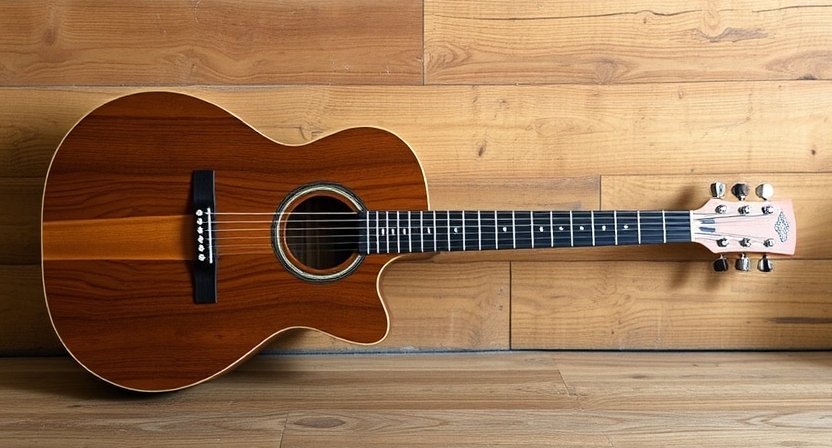
Mahogany is frequently used for guitar backs, sides, and occasionally tops.
- Tone Characteristics: Warm, woody, with a strong midrange focus.
- Best For: Blues, folk, and players who prefer a vintage sound.
4. Rosewood

Rosewood is a premium tonewood often used for backs and sides.
- Tone Characteristics: Deep bass, sparkling trebles, and rich overtones.
- Variants:
- East Indian Rosewood: Balanced and accessible.
- Brazilian Rosewood: Rare and expensive, with unmatched tonal complexity.
- Best For: Fingerstyle and players seeking a luxurious, full-bodied sound.
5. Maple
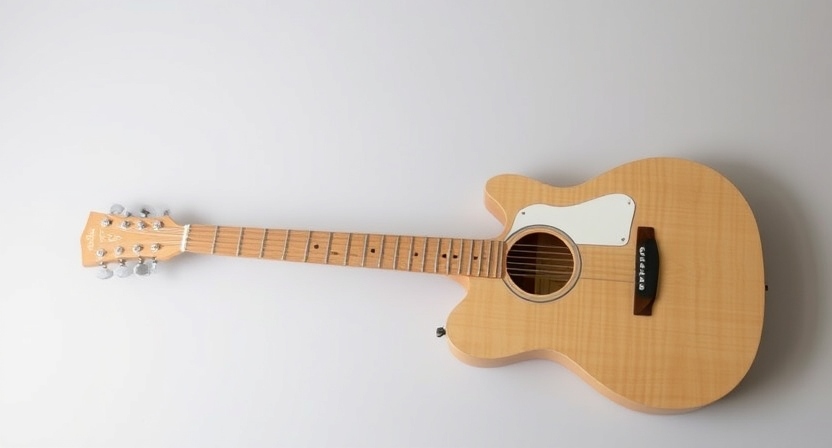
Maple is known for its bright tone and aesthetic appeal.
- Tone Characteristics: Clear, bright, with excellent note separation.
- Best For: Performers needing clarity in live settings.
6. Koa
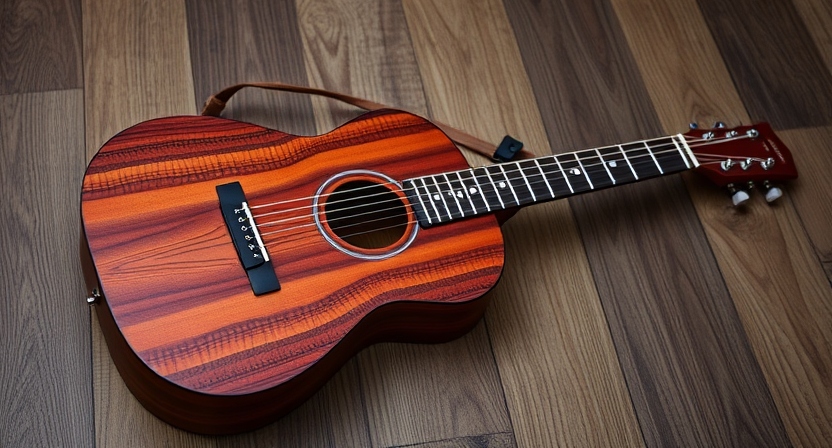
Koa is a Hawaiian wood that combines visual beauty with unique tonal characteristics.
- Tone Characteristics: Warm, balanced, and improves with age.
- Best For: Fingerstyle and players looking for both tone and aesthetics.
7. Walnut
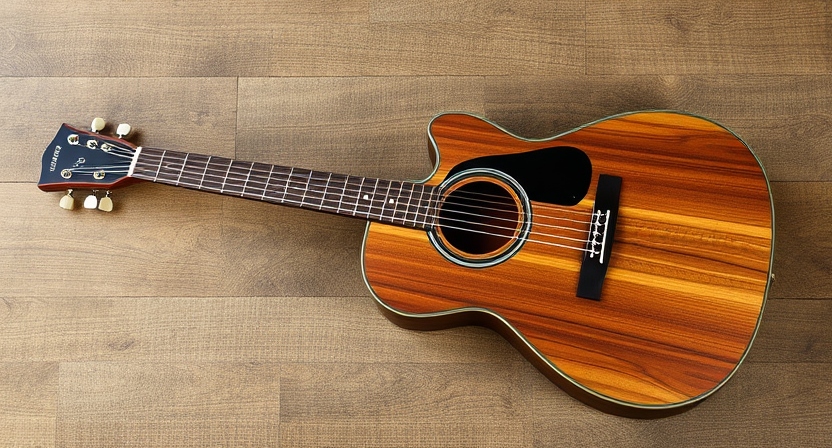
Walnut sits between mahogany and rosewood in terms of tonal quality.
- Tone Characteristics: Warm, earthy, with a slightly bright top end.
- Best For: Versatile players who want balanced sound.
8. Sapele
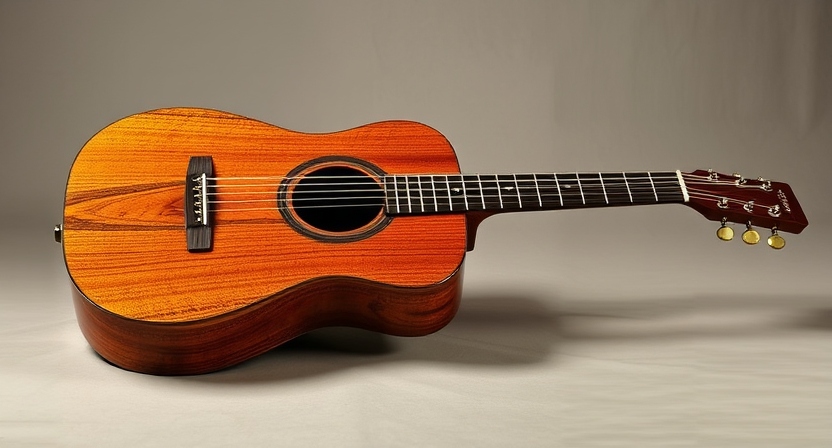
Sapele is a sustainable alternative to mahogany.
- Tone Characteristics: Bright and punchy, with strong midrange presence.
- Best For: Strummers and rhythm players.
How Acoustic Guitar Tonewood Affects Sound
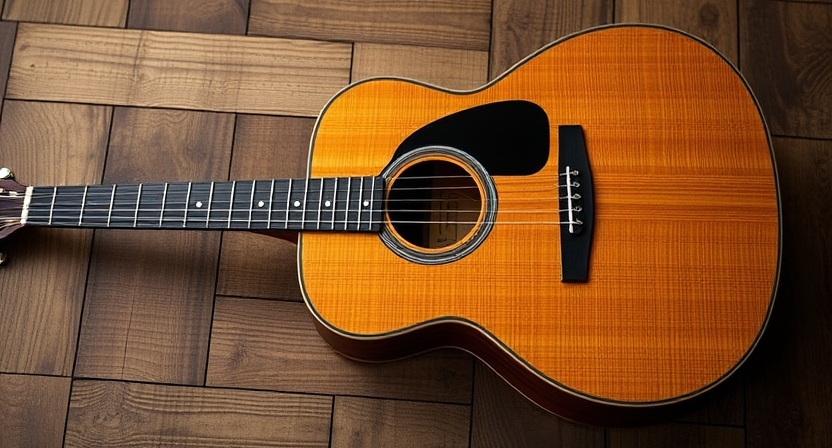
The tonewood influences several aspects of the guitar’s sound:
- Resonance: Denser woods like rosewood resonate deeply, while lighter woods like spruce are more responsive.
- Tone: Woods like cedar provide warmth, while maple delivers brightness and clarity.
- Projection: Certain woods, like Adirondack spruce, offer louder volume and better projection.
Choosing the Right Tonewood for Your Playing Style
Strumming and Rhythm
- Recommended Tonewoods: Spruce, mahogany, sapele.
- Why: These woods provide powerful projection and a balanced tone suitable for bold strumming.
Fingerstyle and Light Touch
- Recommended Tonewoods: Cedar, rosewood, koa.
- Why: These woods respond well to light playing and offer intricate tonal details.
Flatpicking and Leads
- Recommended Tonewoods: Adirondack spruce, maple.
- Why: Their clarity and dynamic range bring out the best in lead lines.
Versatile All-Rounders
- Recommended Tonewoods: Sitka spruce, walnut.
- Why: These woods adapt well to multiple playing styles and genres.
Tips for Selecting an Acoustic Guitar Based on Tonewood
- Test Different Woods: Play guitars with various tonewoods to experience their tonal differences firsthand.
- Match to Your Genre: Choose tonewoods that complement the style of music you play.
- Consider Aging: Some woods, like koa and mahogany, improve in tone with age and use.
- Budget-Friendly Alternatives: If premium tonewoods like rosewood are out of your budget, consider laminates or sustainable options like sapele.
Best Acoustic Guitars for Popular Tonewoods
Spruce:
- Model: Taylor 214ce
- Why: Sitka spruce top for balanced versatility.
Cedar:
- Model: Cordoba C5
- Why: Warm, mellow tone, perfect for classical and fingerstyle players.
Mahogany:
- Model: Martin D-15M
- Why: All-mahogany construction for a rich, woody sound.
Rosewood:
- Model: Yamaha LL16
- Why: East Indian rosewood for a luxurious, full-bodied tone.
Maple:
- Model: Gibson J-200
- Why: Bright tone and iconic jumbo body.
Koa:
- Model: Taylor K24ce
- Why: Exotic appearance and balanced tone.
FAQs About Acoustic Guitar Tonewoods
1. Does tonewood really matter?
Yes! Tonewood affects how the guitar sounds and feels. Different woods emphasize specific tonal ranges, making them more suitable for particular genres or techniques.
2. Can laminate tonewoods sound good?
While solid wood provides superior resonance and tone, high-quality laminates can still sound great, especially for beginners or those on a budget.
3. What’s the best tonewood for beginners?
Spruce tops with mahogany or sapele backs and sides offer a balanced tone and affordability, making them ideal for beginners.
4. Do tonewoods change over time?
Yes, certain tonewoods like koa and mahogany improve with age, becoming richer and more resonant as they “open up.”
Conclusion
The right acoustic guitar tonewood plays a crucial role in shaping your instrument’s sound and feel, enhancing your overall playing experience. Whether it’s the bright and responsive tones of spruce or the warm, full-bodied resonance of mahogany, each tonewood offers a unique voice that can complement your style.
Take the time to explore various options and consider how they align with your musical aspirations. The perfect tonewood isn’t just about sound—it’s about finding the one that inspires you every time you play. Let Aguitar Blog guide you on your journey to discovering the tonewood that brings your music to life.